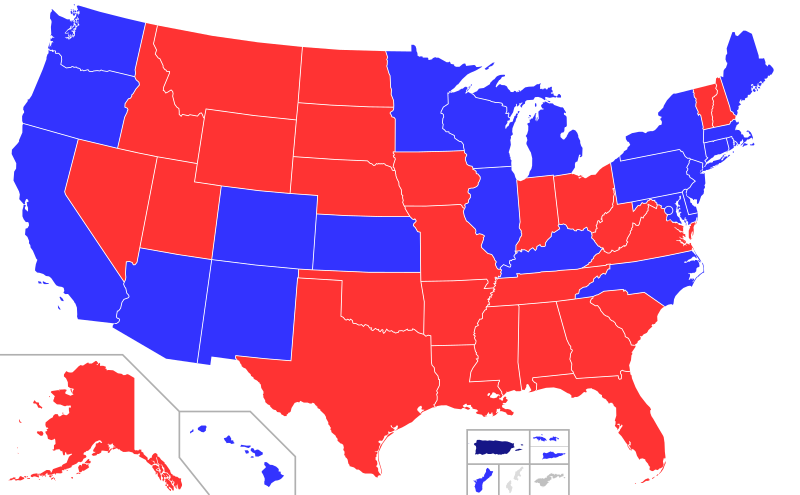 |
| US Senate Solid Colors = 2 of Same Party Purple = 1 of Each Party Stripes = 1 Independent |
First let's look at the US Senate. The Senate tends to be a lagging indicator because it takes six years for the entire body to face reelection. Still, it provides a great deal of insight into the political divide. Counting the two independents who function as Democrats as what they effectively are only 15 states have one senator from each party. That means that 70% of states are represented by two senators of the same party. Nearly all of these states are solidly conservative or liberal with little chance of the Democrats or Republicans winning a statewide office.
 |
| State Governors Alaska's Governor is a Right Leaning Independent |
Let's move on to Governors. Here the picture begins to become more clear. Note that Republicans hold control of governorships in a huge swath of territory from Arizona to North Carolina. In addition, they control most of the former industrial states, the bulk of the Midwest and Mountain West (32 states). Democrats are in solid control of the West Coast and most of the North East (18 states). These numbers can be somewhat deceptive because most of the 18 states Democrats control have high population densities.
Furthermore, the parties are much further apart than ever before. These divisions are no longer simply a matter of how best to accomplish a mostly shared goal, such as economic growth. Today, the two parties represent two radically different world views. The single most reliable predictor of which party someone will vote for is no long class or race. The most reliable predictor is: Does the voter attend religious services regularly. If they do, they are very likely to vote Republican. Today the Republican world view is theistic and includes a belief in moral absolutes. The Democratic world view is secular and includes a belief in moral relativism. Republicans believe strongly in personal responsibility, while Democrats tend to believe in collective responsibility. Republicans believe in the free enterprise system, while Democrats increasingly believe in outright socialism. Republicans believe that our Constitution is to be followed as written and only changed via the amendment process. Democrats believe that our Constitution is a "living document" that can and should be interpreted in any way necessary to accomplish the "greater good". The parties haven't been this far apart since the Civil War.
The conclusion is inescapable: The US is deeply divided not only politically, not only in their fundamental world views, but geographically too. Some foreign observers have even predicted a break up of the US into two or more countries. Let us hope that our democracy and our nation can survive this division - without a second civil war.

No comments:
Post a Comment